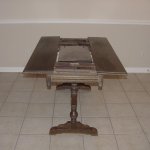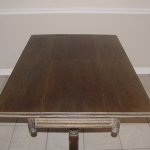larry merlau
Member
- Messages
- 18,741
- Location
- Delton, Michigan
ok i havnt played with sketchup in years,,, but i got to fit a table into a small space.. its replacing a ikea swivel table that was made out of mdf with vinyl laminate around it,, contact paper stuff.. anyway it didnt hold up so i am making this out of real wood but the customer thinks that 12" of over hang wont hold up the food and people using it.. the hinged top will be hinged with sosa type hinges rather than the butler type used on the mdf version. i could lay up the top so the boards ran the long ways on the opened top so wouldnt have the splitting option from weight on one side.. so any help or ideas are welcome. i can email the skb file if someone wants play with my lego project














